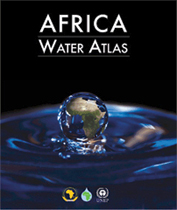The amount of water available per person in Africa is declining and only
26 of the continent's 53 countries are currently on track to reduce by
half the number of people without sustainable access to clean drinking
water by 2015, according to a survey by the United Nations Environment
Programme – UNEP, released. Furthermore, only five countries in Africa
are expected to attain the target of reducing by half the proportion of
the population without sustainable access to basic sanitation by 2015,
the deadline of the Millennium Development Goals – MDGs, a series of
targets agreed to by all countries and leading development institutions
to meet the needs of the world's poorest.
The Africa Water Atlas, compiled by UNEP at the request of the African
Ministers' Council on Water, also maps out new solutions and success
stories on water resources management from across the continent. It
contains the first detailed mapping of how rainwater conservation is
improving food security in drought-prone regions. Images also reveal how
irrigation projects in Kenya, Senegal and Sudan are helping to improve
food security. Some of the most arresting images in the Atlas, which was
launched during Africa Water Week in Addis Ababa, the Ethiopian
capital, include green clouds of eroded soil and agricultural run-off in
Uganda, pollution from oil spills in Nigeria, and a three-kilometre
segment of the Nile Delta that has been lost to erosion.
Prepared in cooperation with the African Union, the European Union, the
United States Department of State and the United States Geological
Survey, the 326-page Atlas gathers information about the role of water
in Africa's economies and development, health, food security,
transboundary cooperation, capacity building and environmental change in
one comprehensive and accessible volume.
"The dramatic changes sweeping Africa, linked with both positive and
negative management of this continent's vital water resources, is
graphically brought home in this Atlas," said Achim Steiner, the
UNEP Executive Director. "From the dams triggering erosion on the Nile
Delta to pollution in the Niger River Basin, the way infrastructure
development or uncontrolled oil spills are impacting the lives and
livelihoods of people are all brought into sharp relief. But so too are
the many attempts towards sustainable management of freshwaters - for
example, the controlled releases from dams on Chad's Logone River that
are restoring in part the natural flooding cycles leading to the
recovery of economically-important ecosystems. "I am sure that the
'before and after images' presented in this Africa Water Atlas can also
catalyze both greater awareness of the challenges and the choices and
decisive, restorative and sustainable action on the ground," added Mr. Steiner.
The Africa Water Atlas also draws attention to Africa's "water towers",
which are sources for many of Africa's trans-boundary rivers and
contribute immensely to the total stream flow of African major rivers.
They supply life-giving resources and services in downstream areas such
as water for hydropower, wildlife and tourism, small-and large-scale
agriculture, municipalities and ecosystem services. The Atlas shows that
most of these water towers, from the Middle Atlas Range in Morocco
through to the Lesotho Highlands in southern Africa, are under extreme
pressure as a result of deforestation and encroachment.
 |
UN News Service – 25-11-2010 |